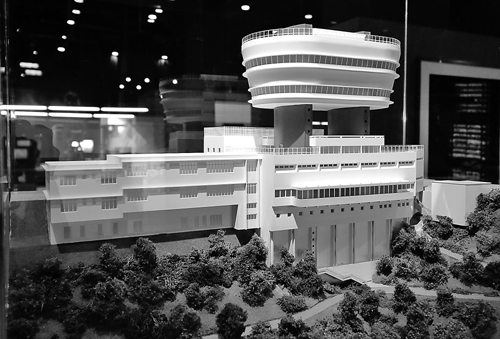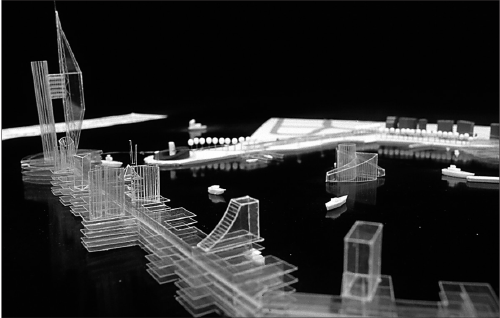
CHINA DAILY
A model of The Peak Tower, created by Fitch & Chung, shows the landmark architectural view of Hong Kong.

CHINA DAILY
West Kowloon Metroplan, a model created byTao Ho.
The fifth M+ mobile exhibition focuses on the museum's architecture collection. Rebecca Lo finds that it chronicles how skylines have developed across the region.
One of the first things that architecture students learn is that buildings are contextual: They should always be designed for a specific site, culture, place and purpose. That is why there are so few architectural museums around the world. It is hardly easy-or appropriate-to stuff a building into a bigger one for public contemplation.
Yet the process of architecture leaves traces in the form of drawings, models and other more size-friendly documents that can be institutionally categorized and exhibited.
For the fifth M+ mobile exhibition, Aric Chen, the museum's design and architecture curator, put together sourced, purchased and donated works by the likes of Frank Lloyd Wright and Steven Holl, as well as local heroes Tao Ho, Eric Lye and Rocco Yim.
M+ is the jewel in West Kowloon Cultural District's crown. Slated for completion in 2017, the competition to design the building drew such international firms as Sanaa, Toyo Ito and Renzo Piano, all of which vied for the coveted role of architect.
Those presentations, alongside the winning scheme by Herzog & de Meuron, make up the first component of the three-part exhibition. The others include M+'s architectural collection after a mere 10 months of sourcing and an interactive area allowing visitors to try their hand at making architecture.
As M+ is a few years away from completion, Chen, chief curator Doryun Chong and executive director Lars Nittve are hoping to generate continuous buzz with a series of pop-up exhibitions held during its development and construction phase.
"I don't limit good architecture to what's iconic," explains Chen, a Chinese-American of Taiwan descent.
"But I'm not against the architect as celebrity, either. A lot of 'starchitects' are innovative thinkers and space makers. Yet architecture is more than just flashy buildings. It's an integral part of life and society, and impacted by economic and social factors. We have some examples of iconic buildings. We also have artists such as photographer Iwan Baan who question iconic architecture."
One of Baan's photos shows the Bird's Nest in Beijing under construction, with workers in the foreground taking a break and watching television. "It's ironic that a building made for media consumption should show that," Chen says.
One of the most important works in the collection is the influential American architect Frank Lloyd Wright's sketches for the demolished Imperial Hotel in Tokyo. It shows the influence of Eastern concepts in Wright's design, along with perhaps the work of the first "starchitect" in Asia.
There is former dean of the University of Hong Kong's Faculty of Architecture Eric Lye's winning scheme for the Hong Kong University of Science and Technology, which never got built. There are snapshots of abandoned construction sites all over China, filtered through the camera lens of Stanley Wong, Hong Kong's "anothermountainman". And there is a model of The Peak Tower by Fitch& Chung as it was originally constructed in the early 1970s.
"As curators, we use our personal voices to tell a story," says Seoul-born, US-educated Chong.
"We do it in discourse with other professionals and always without arrogance. Although we are specialists, our story may not always be true. We can revise. We want the best works for M+, but those decisions will always be subjective."
Nittve, who's from Sweden, says: "Museums today have steadily growing audiences. Despite living our lives in a mediated format, it seems that people are looking for the real thing: one-to-one experiences. They want the here and now."
He believes that Hong Kong's colonial legacy may have something to do with its lack of great public cultural institutions-or its citizens' perception that museums are boring and stuffy. "The argument that people don't want to pay to see things that they don't know about may be an argument for free admission to M+," Nittve says.
"Hong Kong people have a healthy curiosity toward contemporary culture. I think that this city is ready-and maybe even a little impatient-for a museum like ours."
Contact the writer at sundayed@chinadaily.com.cn.
IF YOU GO
The Museum and Architecture Collection, M+, ArtisTree, 1/F Cornwall House, TaiKoo Place, 99 King's Road, Island East, Hong Kong.
10 am-8 pm, until Feb 9.
852-2200-0204.
